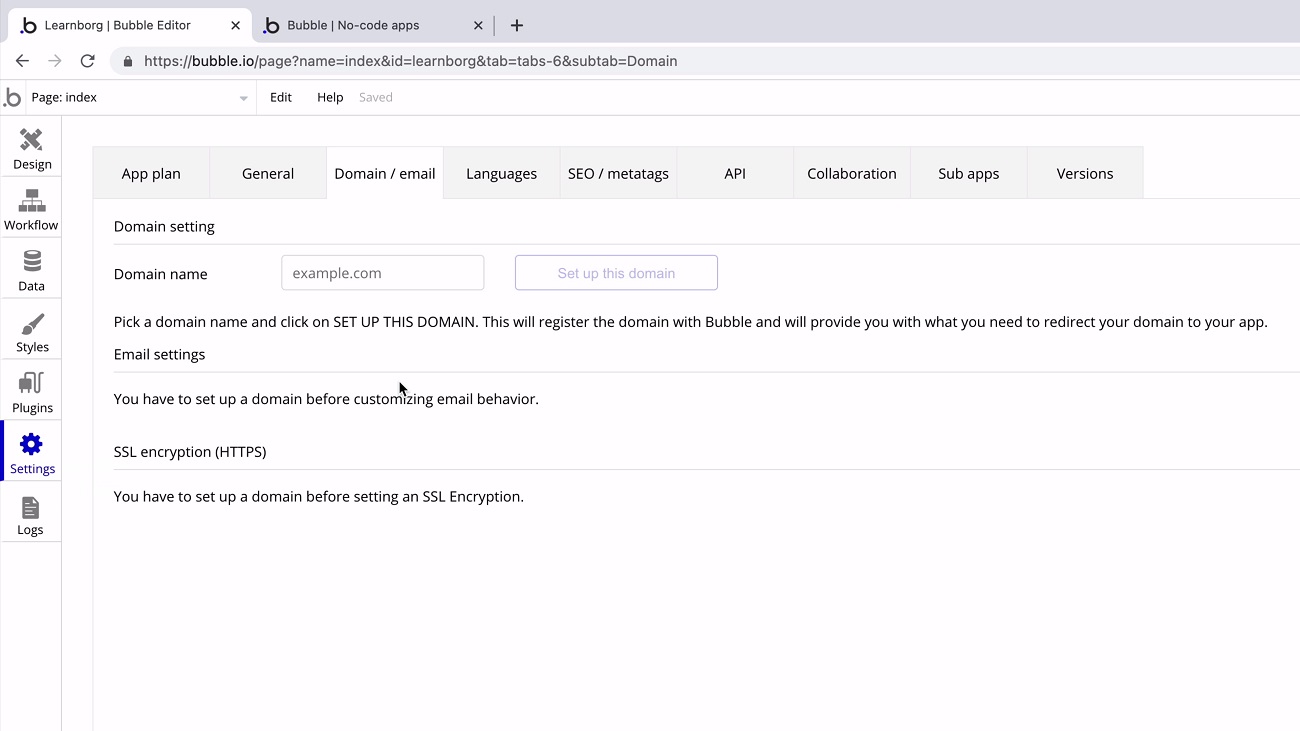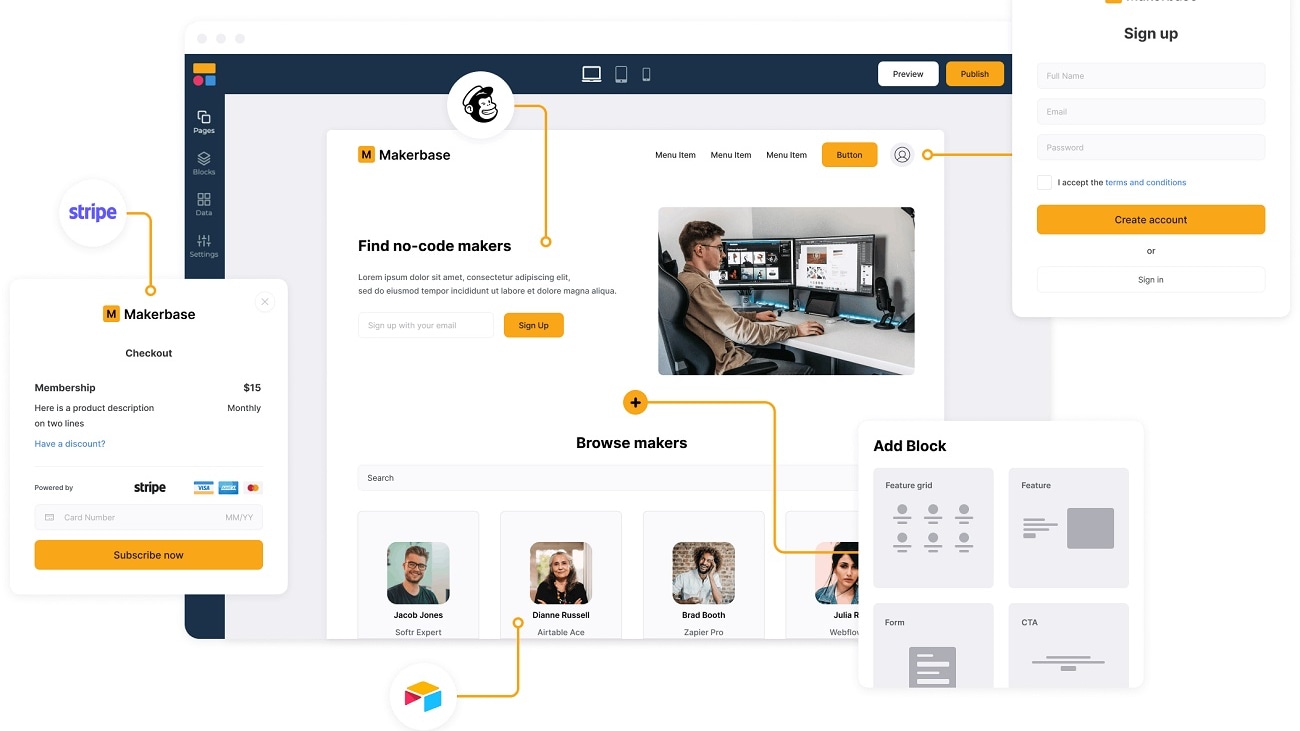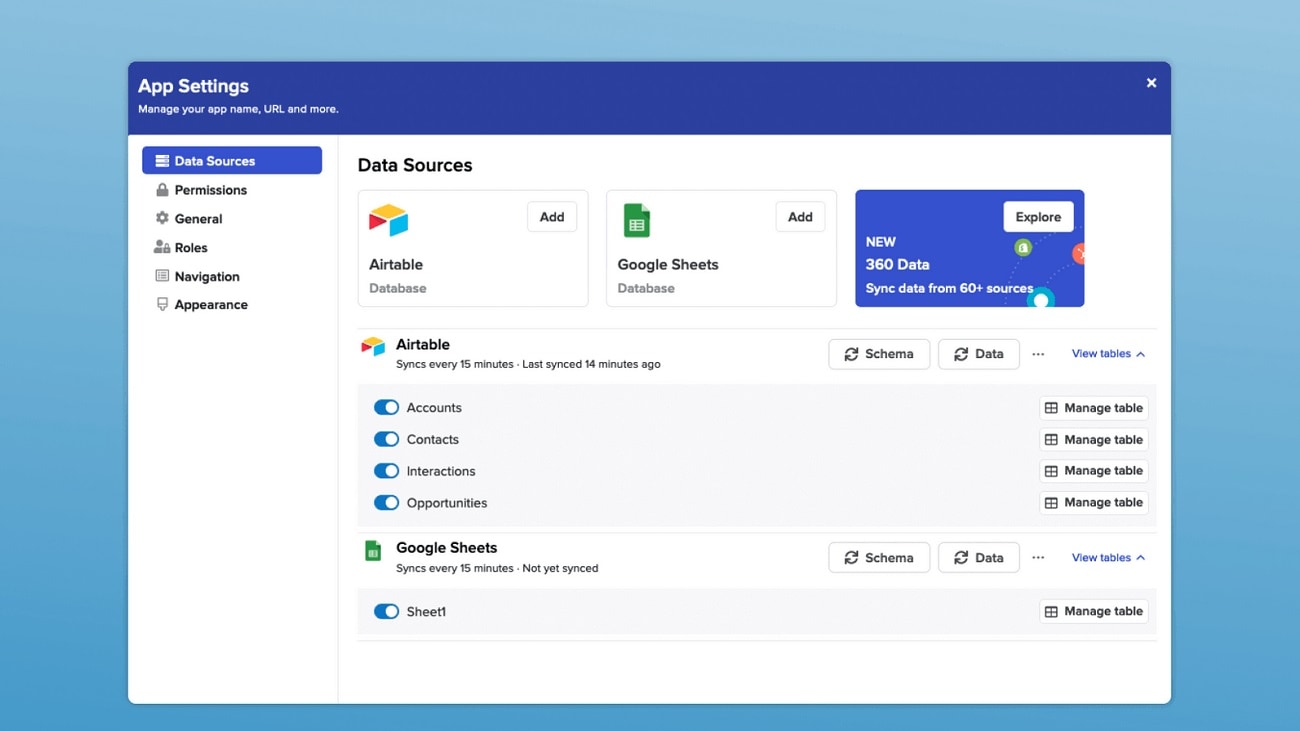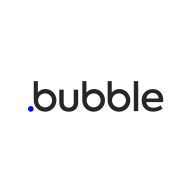Softr vs Bubble: Choosing the best tool for your business
- 01Softr vs Bubble: overview
- 02What's the difference between Softr and Bubble?
- 03Softr pros and cons
- 04Bubble pros and cons
- 05Softr compared to Bubble
- 06Bubble compared to Softr
- 07Features comparison
- 08Softr vs Bubble: Which is the best for your business?
- 09Promotions on No-Code Development software
- 10Alternatives to Softr & Bubble
Access up to $100 savings on Softr & $1,436 on Bubble
Access up to $100 savings on Softr & $1,436 on Bubble
App development is now accessible to all, thanks to the rise of no-code platforms. These solutions have a range of use cases, from simplifying internal business processes to building full-scale SaaS products. But, given the range of options, it can take time to figure out where to start when choosing the right solution for your business.
To help you out, we’ve compared two leading no-code platforms, Softr vs Bubble. By looking at their features, strengths, weaknesses, and critical differences, by the end of this article, you’ll be able to make an informed decision as to which platform best aligns with your business needs and goals. Let’s dive in!
Softr vs Bubble: overview
Softr and Bubble are two leading figures in the realm of no-code web application platforms, each flaunting its distinct array of functionalities tailored to meet the diverse needs of builders and businesses.
Softr is lauded for its user-friendly interface that allows anyone to create web applications, websites, and landing pages without writing a single line of code. With a variety of customizable templates and drag-and-drop modules, Softr is tailored for those who prioritize simplicity and rapid deployment. On the other hand, Bubble provides a more extensive toolset that gives users the power to create intricate web applications with rich functionality. It is known for its visual programming approach, which permits builders to handle backend processes, data operations, and user authentication, among others, without delving into traditional coding.
Now, let's explore the Softr vs. Bubble comparison to guide you in making a judicious decision when pinpointing the most suitable no-code platform for your specific web-building objectives.
What's the difference between Softr and Bubble?


Softr and Bubble are both powerful no-code platforms in their own right. However, some crucial differences between them may guide your decision-making. One of the main distinctions is the platforms’ focus and corresponding features. Bubble is ideal for building complex, scalable web apps like SaaS. You can also use it to build internal apps and workflows. For this, it offers a high level of customization and advanced features, which can involve a steeper learning curve. Softr is designed for users with no technical expertise. As a result, it excels at building straightforward apps like job boards, static websites, and blogs. While it offers fewer customization options, it’s very easy to make and deploy apps quickly with Softr.
When it comes to templates, Softr offers an extensive range of 100s of native templates optimized for all devices, including web, mobile, and tablets. Bubble, on the other hand, doesn’t offer any native templates. Instead, it has 1000s of community-built options, ranging from basic templates to more technical, advanced templates.
Finally, there are differences in the platforms’ pricing. Softr and Bubble offer free plans but with different inclusions. If you’re considering a free plan, check these closely to see which one offers the features you need. Both platforms have 4 paid plans. Softr offers a Basic plan for $49/month, a Professional plan for $139/month, a Business plan for $269/month, and an Enterprise plan (pricing on request). In comparison, Bubble has a Starter plan for $29/month, a Growth plan for $119/month, a Team plan for $349/month, and an Enterprise plan (pricing on request). If you’re considering a lower plan, Bubble represents the more affordable option. However, if you need a higher-tier plan, Softr becomes the more cost-effective choice at the Business/Team level.

20% off the Professional plan for 3 months on Softr
Get 20% off the Professional plan for 3 months on Softr and up to $100 savings with Secret.
Softr pros and cons
What are the advantages of Softr?
- User-friendly interface: Softr's interface is designed for simplicity, making it easy for beginners to start building web applications or sites without a steep learning curve.
- Pre-built templates: Softr offers a range of templates for various purposes, from blogs to online stores, allowing users to get started quickly and customize as per their requirements.
- Integration capabilities: Softr seamlessly integrates with popular tools and platforms, including but not limited to Airtable, enhancing its functionality.
- Performance and speed: Web applications and websites built with Softr tend to load quickly, ensuring a good user experience.
- Affordable pricing: Compared to some other platforms, Softr provides a competitive pricing model which is accessible for individuals and small businesses.
What are the disadvantages of Softr?
- Limited advanced functionalities: For complex web applications with intricate backend processes, Softr might not be the best choice as its capabilities are somewhat limited in this respect.
- Less control over design: While Softr offers customization, there might be constraints in terms of achieving highly unique or out-of-the-box designs.
- Scalability concerns: For large-scale applications with thousands of users and extensive data management, Softr may not be the ideal choice in terms of scalability.
- Dependency on external platforms: Since Softr often relies on integrations (like with Airtable) for extended functionality, users might face challenges if these external platforms change their API or functionalities.
- Limited to no-code: Unlike some platforms that allow users to dive into the code if needed, Softr is predominantly a no-code platform, which might be limiting for some advanced developers.
Compare Softr to other tools
Bubble pros and cons
What are the advantages of Bubble?
- Extensive functionality: Bubble offers a broad spectrum of features, allowing users to build intricate web applications without traditional coding. This includes backend processes, data operations, and user authentication.
- Visual programming: Bubble's drag-and-drop interface allows users to visually design both the frontend and backend logic, making it easier to understand and implement complex functionalities.
- Customizability: Users have significant control over the design and functionality of their applications. They can make applications look and feel exactly the way they want.
- Integration potential: Bubble offers a variety of plugins and the ability to connect with numerous third-party tools and services through APIs, making it highly versatile in terms of integration.
- Active community: Bubble boasts a vibrant and active community. This means new users can tap into a wealth of shared knowledge, resources, and templates.
What are the disadvantages of Bubble?
- Steep learning curve: Although Bubble is a no-code platform, its wide range of features and functionalities can make it intimidating for absolute beginners.
- Performance concerns: As applications built on Bubble become more complex, there can be concerns related to speed and performance.
- Pricing: As your application grows and demands more resources or functionalities, Bubble's pricing can become relatively high, especially for startups or individual developers.
- Limited to web applications: Currently, Bubble is predominantly focused on web applications. While it's possible to create mobile-responsive designs, building native mobile apps is not its primary strength.
- Less control than traditional coding: While Bubble offers a lot of flexibility, there will always be some limitations compared to building an application from scratch using traditional coding. Some specific custom functionalities might be hard or impossible to implement.
Compare Bubble to other tools
Softr compared to Bubble
Softr and Bubble are both notable players in the no-code web application landscape, but they cater to different user needs. Softr, with its user-friendly interface and pre-built templates, appeals to those looking for a straightforward way to construct web applications, websites, or landing pages without getting bogged down in complexities. Its emphasis on simplicity and speed allows rapid deployment, making it ideal for beginners or those prioritizing quick launches.
In contrast, Bubble, with its visual programming approach, provides a broader toolset, enabling users to create more intricate web applications with rich functionality. It's suited for those desiring deeper customization and control, albeit with a steeper learning curve.
Is Softr better than Bubble?
Determining whether Softr is better than Bubble depends on the specific needs and preferences of the user. Softr offers a streamlined and user-friendly interface ideal for those who value simplicity and quick project turnaround. Its intuitive design makes it a favorite among beginners or those seeking a no-fuss web-building experience.
On the other hand, Bubble's more extensive toolset caters to users who wish to delve into deeper functionalities and customizations. While Bubble might present a steeper learning curve, it provides greater flexibility for intricate web application development. Therefore, the "better" platform hinges on individual project requirements and user proficiency.
What is Softr best used for?
Softr is best utilized for individuals and businesses aiming to swiftly create web applications, websites, or landing pages without diving into the intricacies of coding. Its user-centric design emphasizes simplicity, making it an excellent choice for beginners or non-developers.
With a selection of customizable templates and seamless integration capabilities, especially with platforms like Airtable, Softr is particularly suited for projects that prioritize rapid deployment and a straightforward building process. Whether it's setting up a blog, an online store, or a portfolio site, Softr provides an efficient and hassle-free solution to bring digital ideas to life with minimal technical barriers.
Can Softr replace Bubble?
Whether Softr can replace Bubble is contingent on the specific requirements and complexity of a project. While both platforms operate within the no-code realm, they cater to varied needs. Softr, with its emphasis on simplicity and rapid deployment, is ideal for straightforward web applications and sites. It's perfect for those who want a hassle-free, efficient building experience.
Bubble, however, offers deeper functionalities and a broader toolset, making it suitable for more complex applications that require nuanced customizations. While Softr could replace Bubble for some users and projects, for others seeking extensive capabilities, the distinction between the two remains significant.
Is Softr cheaper than Bubble?
Softr and Bubble employ different pricing models that cater to varied user needs and project complexities. Softr's pricing often appeals to individuals and smaller businesses due to its competitive rates, especially for basic web projects. It provides an accessible entry point for those venturing into the no-code space.
Conversely, Bubble's pricing can escalate based on the functionalities, resources, and plugins employed in a project. While Bubble may offer a free tier or starter plan, scaling an application with advanced features might incur higher costs. Consequently, while Softr may initially seem more affordable, the ultimate cost comparison hinges on the specific requirements and scale of the intended project.
Is there a better No-Code Development software than Softr?
When exploring the no-code web application landscape, it's essential to ponder if there's another software that better aligns with your distinct requirements.
Some notable alternatives to Softr in the no-code domain include Bubble, Wix, Webflow, Adalo, and OutSystems. The selection of a web-building platform hinges on your project's intricacies, the level of customization desired, scalability demands, and budgetary constraints. While Softr shines with its user-friendly interface and rapid deployment, other platforms might provide more in-depth functionalities, granular design controls, or specialized features that resonate more aptly with your web development and design aspirations.
20% off the Professional plan for 3 months on Softr
Get 20% off the Professional plan for 3 months on Softr and up to $100 savings with Secret.
Bubble compared to Softr
Bubble and Softr both occupy significant positions in the no-code web development ecosystem but serve distinct user preferences. Bubble, known for its comprehensive toolset, offers users the ability to design intricate web applications using a visual programming approach. Its expansive feature set allows for deep customizations and the creation of complex functionalities without traditional coding.
In contrast, Softr stands out with its emphasis on simplicity and speed. Tailored primarily for those seeking a straightforward web-building experience, Softr's user-friendly interface and pre-designed templates facilitate the rapid deployment of web applications and sites. The choice between the two hinges on project complexity and user proficiency.
Is Bubble better than Softr?
The evaluation of whether Bubble is better than Softr largely depends on the context and requirements of a project. Bubble, with its expansive toolset, caters to users looking for deep customizations and intricate web application functionalities. Its visual programming framework allows for a nuanced design of both frontend and backend processes, making it a favorite among those desiring comprehensive control.
Meanwhile, Softr emphasizes simplicity, speed, and a straightforward web-building experience, making it ideal for beginners or projects requiring quick turnaround. Essentially, neither platform is universally "better," but each excels in specific scenarios based on the user's goals and expertise level.
What is Bubble best used for?
Bubble is best recognized for empowering users to construct intricate web applications without resorting to traditional coding. Its strength lies in the visual programming approach, which facilitates the design of both frontend interfaces and backend logic within a unified environment.
From startups launching MVPs (Minimum Viable Products) to businesses creating custom internal tools, Bubble's flexibility makes it a viable choice for a wide range of applications. Its extensive plugin library and API integration capabilities further enhance its adaptability, allowing for the creation of dynamic platforms, marketplaces, social networks, and more. With Bubble, intricate digital solutions become accessible even to non-developers.
Can Bubble replace Softr?
Bubble's capacity to replace Softr is contingent on the scope and specifics of a project. With its visual programming interface, Bubble offers a robust toolset, enabling the creation of complex web applications that require deep customization and logic-driven processes. Its adaptability extends to diverse digital projects, from marketplaces to social networks.
Conversely, Softr, with its focus on simplicity and speed, is tailored for users who seek an intuitive, rapid web-building experience. While Bubble can functionally accomplish what Softr offers, the reverse might not always hold true. Therefore, while Bubble could serve as an alternative to Softr for many, the ideal platform choice remains project-dependent.
Is Bubble cheaper than Softr?
Bubble and Softr operate on varied pricing models, reflecting their distinct toolsets and targeted user bases. Bubble's pricing can vary significantly based on functionalities, resources, and plugins incorporated into a project. While it provides a free tier, scaling an intricate application can lead to higher costs.
Softr, catering to a different segment with its emphasis on straightforward web projects, might offer pricing more accessible to individuals or small businesses. However, as projects grow in complexity and demand more features, the cost difference might narrow. Ultimately, whether Bubble is cheaper than Softr depends on the specific requirements, scale, and duration of the intended project.
Is there a better No-Code Development software than Bubble?
When considering alternatives to Bubble in the no-code application-building realm, it's vital to discern if there's a platform that better resonates with your particular development aspirations.
Some prominent alternatives to Bubble in the no-code web application arena include Softr, Webflow, Adalo, OutSystems, and Glide.
Choosing a no-code platform revolves around your project's intricacies, desired customization levels, scalability requirements, and budgetary parameters. While Bubble stands out for its extensive functionalities and visual programming approach, other platforms might have an edge in user-friendliness, mobile app development, specific integrations, or design flexibility.
30% off across all plans for 1 year on Bubble
Get 30% off across all plans for 1 year on Bubble and up to $1,436 savings with Secret.
Features comparison
Softr Outshines Bubble with Streamlined Secure Payment Integration

In the competitive landscape of no-code platforms, Softr takes the lead when enabling secure payments within applications. Imagine an artisan launching an online store to sell handmade crafts; with Softr, they can effortlessly set up a payment gateway, confident in its security protocols. Softr's built-in payment integration not only eases transactions but also diligently addresses all regulatory and security concerns. This holistic approach means businesses can channel their energies towards product development, marketing, and customer service, rather than payment intricacies.
In contrast, while Bubble offers a plethora of features, it doesn't natively list this direct secure payment capability, making Softr a more appealing choice for those prioritizing transactional functionalities.
Softr Dominates Bubble in Harnessing Business Data for App Creation

When it comes to extracting value from existing business data to drive application development, Softr undeniably emerges as a frontrunner. Its innate ability to flawlessly mesh with platforms like Airtable or Google Sheets is a boon for businesses. Consider a retailer with a vast inventory on Google Sheets; Softr can effortlessly utilize this data to craft an e-commerce platform tailored to the retailer's needs.
Bubble, although armed with a strong database management system, often requires a more hands-on approach to data integration. While it can build intricate applications, its focus isn't necessarily anchored on directly harnessing pre-existing business data in the same streamlined manner as Softr.
Bubble's One-Click Hosting Surpasses Softr's Deployment Ease

When discussing the hassle-free deployment of applications, Bubble's one-click hosting emerges as a game-changer. Consider an entrepreneur ready to unveil a new e-commerce platform; with Bubble, the entire process can be distilled to a mere click, launching the application on their robust cloud infrastructure.
Beyond the initial deployment, Bubble's system is inherently designed to adjust to fluctuating traffic volumes, ensuring optimal performance even during unexpected spikes. Think of a sudden surge in users during a holiday sale; Bubble effortlessly handles the influx. While Softr offers its hosting solutions, the immediacy and scalability packed by Bubble's offering make it a clear forerunner in this domain.
Softr Shines in User-Friendly Design Compared to Bubble's Comprehensive Toolset

Softr undoubtedly clinches the top spot when it comes to user-friendliness and intuitive design. Designed with the non-technical entrepreneur in mind, its interface is refreshingly simple. One of its standout features is the drag-and-drop system, which allows even complete beginners to craft professional-quality web applications. For instance, a small business owner could swiftly set up an online store by merely choosing an e-commerce template and populating it with products.
Bubble, in contrast, while powerful and versatile, demands a deeper dive. Its capabilities extend to intricate applications but necessitate an understanding of workflows, data structures, and logic. For someone who wishes to quickly launch a project without wading through complex functionalities, Softr emerges as the clear choice.
Bubble Outshines Softr with Expansive Integration Capabilities

When it comes to integration possibilities, Bubble undoubtedly stands as a formidable contender. What sets Bubble apart is its robust API Connector, which offers users the flexibility to seamlessly integrate with nearly any third-party service. Imagine a startup wanting to incorporate a unique CRM tool, a specialized payment gateway, and a niche marketing platform; Bubble's adaptability can make this possible without much hassle.
On the flip side, Softr, though user-friendly, mainly provides pre-set integrations with well-known platforms such as Mailchimp for email campaigns, Zapier for workflow automations, and Stripe for payment processing. While these integrations cater to common needs, for projects demanding a broader spectrum of interconnected tools, Bubble's expansive integration suite emerges as the more versatile choice.
Bubble Edges Out Softr with Superior Application Stability Features

In the critical domain of application stability and reliability, Bubble undoubtedly emerges as the more formidable player. Consider a scenario where a developer introduces a new feature, only to find it disrupts some of the existing functionalities. With Bubble's adept version control and rollback mechanism, one can effortlessly revert to a previous stable version, ensuring continuity in user experience. This safeguard, akin to having a safety net, drastically reduces potential downtimes.
While Softr offers an array of commendable features, it currently does not provide this specific layer of protection that Bubble deftly integrates, making Bubble a preferred choice for those seeking enhanced stability assurances.
Softr and Bubble Go Head-to-Head in Streamlined App Creation

In the arena of no-code application development, both Softr and Bubble champion user-centric design, placing them at parity in terms of building ease. With their state-of-the-art drag-and-drop interfaces, even novices can embark on ambitious projects.
Picture a startup founder wanting to prototype a novel social media platform; Bubble's tools can bring that vision to life seamlessly. Meanwhile, a local non-profit aiming to gather community insights can swiftly set up custom forms using Softr, ensuring they gather meaningful data. The choice between these platforms isn't about simplicity, as both have mastered this domain; instead, it hinges on specific project needs and desired features.
Subscribe to our newsletters.
No FOMO here. Stay up-to-date on all the latest deals and news with our monthly newsletter straight to your inbox like 127,000+ entrepreneurs (+ Get 10% off on on our Premium Membership!)
Softr vs Bubble: Which is the best for your business?
Softr is the best tool for you if:
- You prioritize an easy-to-use interface designed specifically for those without a technical background or coding knowledge.
- You're looking for direct and seamless integrations with popular databases like Airtable and spreadsheet tools such as Google Sheets.
- You want a streamlined process for setting up and accepting secure payments directly within your application or website.
- You're keen on using a range of beautifully designed templates that make website and application creation feel effortless.
- You value platforms that continually offer updates and enhancements based on user feedback and the latest design trends.
Bubble is the best tool for you if:
- You thrive on deep customization options and wish to connect your application to various third-party services via APIs.
- You anticipate frequent updates and need a robust version control system to manage and rollback changes efficiently.
- You're aiming to build applications with complex workflows, logic, and data structures without diving into coding.
- You prefer platforms that come with a built-in hosting solution, ensuring your project is online instantly upon completion.
- You're seeking a community-driven platform with extensive tutorials, resources, and plugins developed by its dedicated user base.

20% off the Professional plan for 3 months on Softr
Get 20% off the Professional plan for 3 months on Softr and up to $100 savings with Secret.
Alternatives to Softr & Bubble
Promotions on No-Code Development software
Start saving on the best SaaS with Secret.
Secret has already helped tens of thousands of startups save millions on the best SaaS like Softr, Bubble & many more. Join Secret now to buy software the smart way.


















